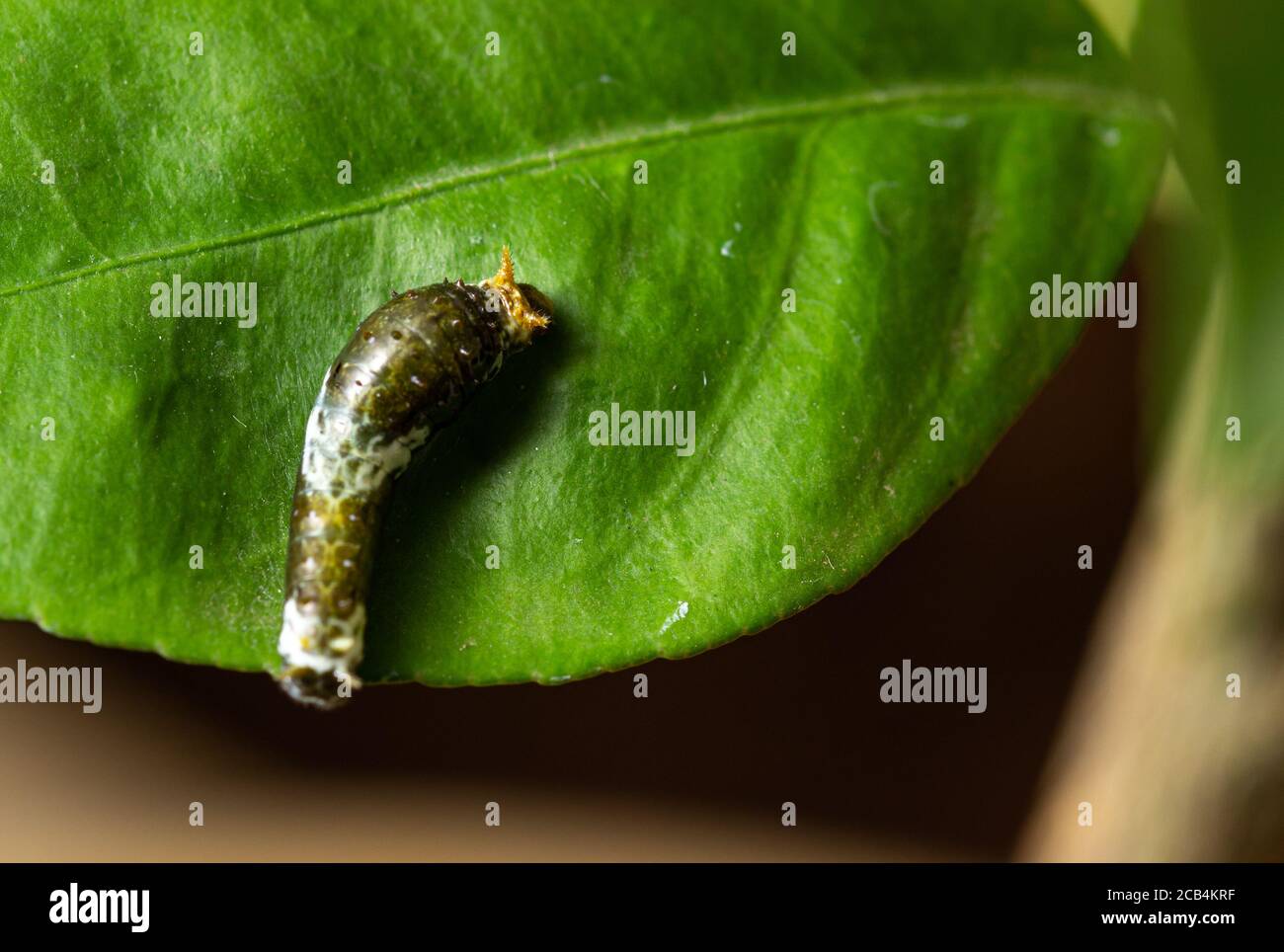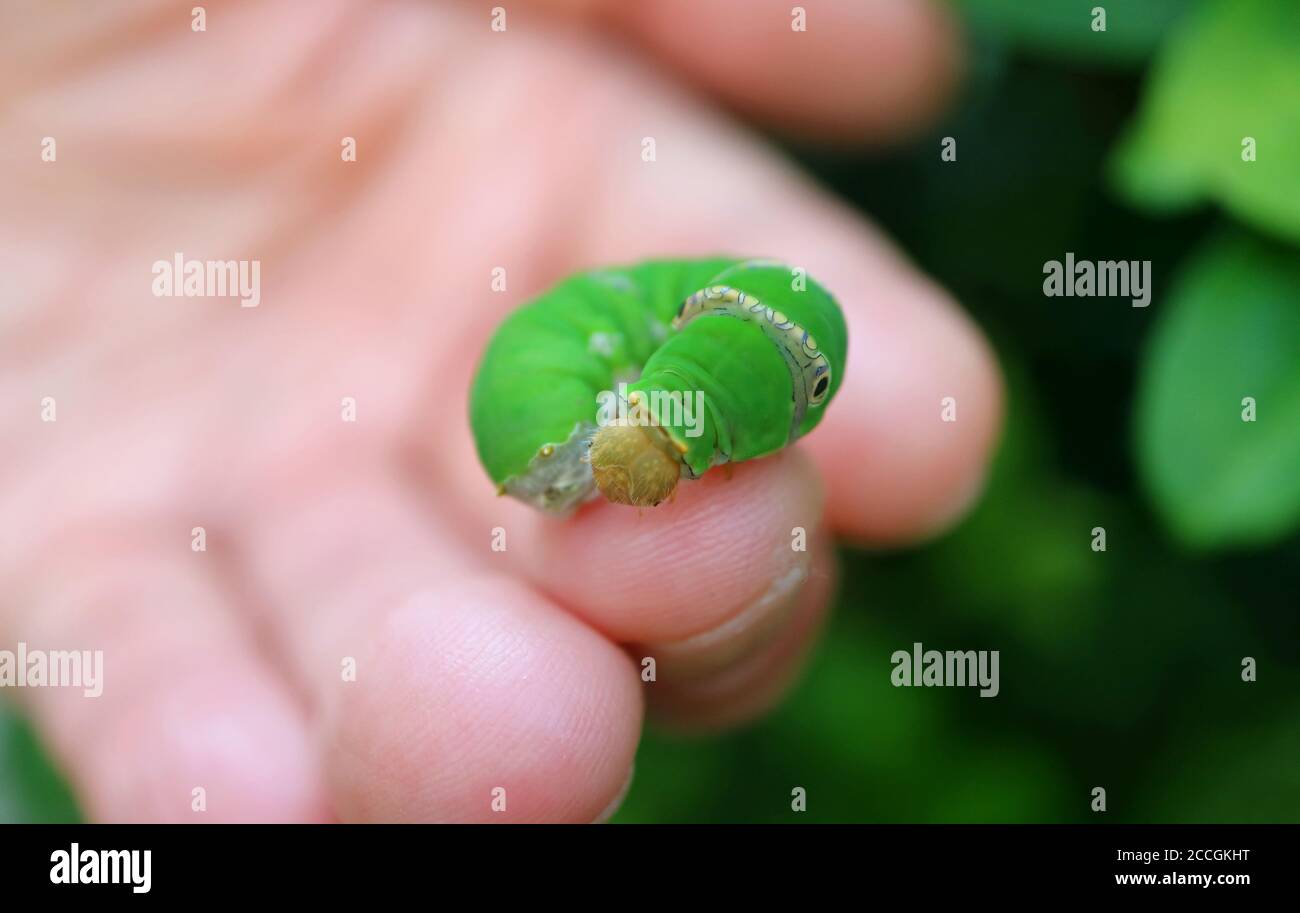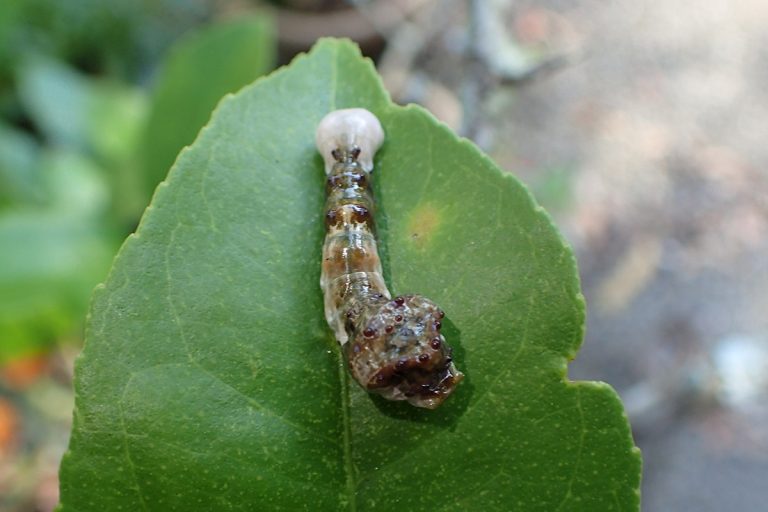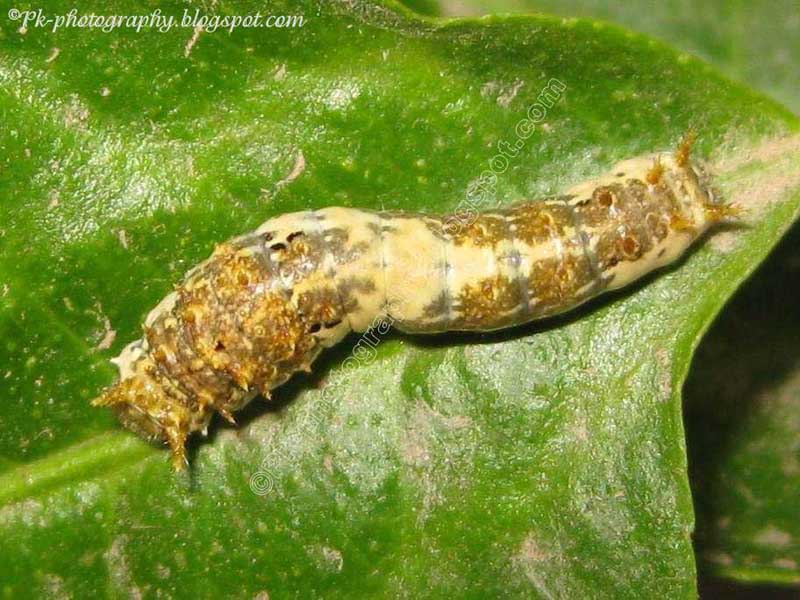
Citrus caterpillar relaxing on leaf also known as lemon tree caterpillar Stock Photo Alamy
The caterpillar of this non-native butterfly can defoliate a citrus tree, on your solution for Florida-Friendly gardening from the University of Florida's Center for Landscape Conservation and Ecology.

Small caterpillar On the leaf of a lime tree on my drivewa… Flickr
Meet "Limey", the lime-eating caterpillar: We have a kaffir lime tree in a large clay pot in our carport. Kaffir lime is a wonderful ingredient in Southeast Asian cooking, particularly Thai dishes. We've used kaffir lime leaf in many recipes, including Stir fried Pork with Long Beans, Thai Green Curry, and Wild Salmon Cakes with. Continue reading Common Lime Swallowtail Butterfly.

Giant Swallowtail caterpillar on lemon tree. I found a swa… Flickr
The fully grown Lime Hawkmoth caterpillar has a maximum length of 65mm, green with pale lateral stripes. Some develop small, red, sub dorsal markings. Notable features of the caterpillar are the curved blue tail horn with hints of red and yellow on the underside. Beneath the tail horn is a small cluster of raised yellowy orange tubercles.

Vertical Image of Vivid Green Lime Swallowtail Caterpillar Crawling on a Lime Tree Branch Stock
The citrus swallowtail caterpillar often called the "citrus swallowtail" or "citrus orange dogs" of citrus trees, is the larva of the giant swallowtail butterfly (Papilio cresphontes cramer). This caterpillar is a big problem for the gardens of the United States and other citrus-growing countries.

Closeup a Vivid Green Lime Tree Caterpillar on the Finger Stock Photo Alamy
Citrus Swallowtail caterpillar is a large fat lime-green caterpillar that loves to feed on the leaves of citrus trees. This type of caterpillar is slightly hairy in its immature stage and gradually develops a smooth body as it matures. Type of Furry or Fuzzy Caterpillars with Pictures - Caterpillar Identification.

A Caterpillar Crawls on a Lime Tree Stock Image Image of color, botany 237651085
The caterpillars are camouflaged to look like bird droppings as to help them blend in and avoid predation. Host plants for the Giant Swallowtail are wild lime (zones 9A-11) (including other citrus trees such as sweet orange), Hop Tree (zones 3-9) , Prickly Ash (zones 3-7) and Common Rue (zones 5-9). I'm growing (pushing the zone here in 10A.

Jarowair Our Patch Lemon Tree Caterpillar
is the largest butterfly in the United States and Canada with a wing span reaching between 4 inches to over six inches. Zanthoxylum americanum, common rue, Ruta graveolens, and hop tree, Ptelea trifoliata. On the left you'll see a mature caterpillar (disguised as a bird dropping). The one on the right is a younger caterpillar.

Two Caterpillar on a Lime Tree Stock Photo Image of crawl, invertebrate 237570518
Caterpillar Food Plants Lime ( Tilia sp. ), elms ( Ulmus sp. ), Alder ( Alnus glutinosa ), Downy Birch ( Betula pubescens) and Silver Birch ( Betula pendula ). In London, Plane ( Platanus x hispanica) and cultivars of Cherry. Habitat Broadleaved woodland, urban areas, parks and gardens in lowland areas. Distribution Countries: England, Wales

Lemon Tree Caterpillar
When you spot caterpillars on your lime tree, you don't necessarily need to grab a synthetic pesticide. You can remove caterpillars organically. Handpick The Caterpillars This is the most organic way of removing caterpillars from a tree. If your lime tree is not very high, you can inspect it and pick off the caterpillars by hand.

Closeup a Green Lime Tree Caterpillar on Human`s Fingers Stock Image Image of lemon, macro
Papilio demoleus is a common and widespread swallowtail butterfly. The butterfly is also known as the lime butterfly, [1] [2] lemon butterfly, lime swallowtail, and chequered swallowtail. [2] These common names refer to their host plants, which are usually citrus species such as the cultivated lime.

Giant swallowtail caterpillar on Meyer Lemon tree leaf. The WFSU Ecology Blog
I regularly have citrus butterfly larvae (caterpillars) on my citrus trees - especially my lime tree. There are two native butterfly species which visit: lar.

Caterpillar Eat Leaf from Lime Tree Stock Image Image of leaf, tree 256095737
2. Tomato and Tobacco Hornworm Moths. Scientific name: Manduca genus. The tomato hornworm and its very close relative the tobacco hornworm are among the most common and destructive insects in the Northern Hemisphere. The tomato hornworm is a huge green caterpillar that eats tomato leaves and young fruit, and if you find one on your vines then.

Vibrant Green Lime Swallowtail Caterpillar Resting on a Lime Tree Leaf Stock Photo Image of
The provenance of Old World swallowtail butterflies, Papilio demoleus (Lepidoptera: Papilionidae), recently discovered in the New World. Annals of the Entomological Society of America 99:164-168. Heppner, John B. 2006 "Lime Swallowtail in the Caribbean and Possible Impacts for Florida Citrus" Florida Department of Agriculture and Consumer.

Vivid Green Lime Swallowtail Caterpillar Crawling on a Lime Tree Leaf Stock Photo Image of
The magnificent Large Citrus Butterfly Take Jerry Coleby Williams advice (ABC Gardening Australia) and if you find more than one caterpillar on your citrus tree, just move one to another tree - to lessen any damage they may do to the leaves, and enjoy two beautiful butterflies when they emerge from their cocoons.

Caterpillar Looking for Food on Leaf Lime Tree Stock Photo Image of shrub, insect 256199048
Description (Back to Top) Adult: Adult giant swallowtails are large butterflies with a forewing span of 11.7 to 17.5 cm) (avg. 14 cm) for males and a span of 13.5 to 18.8 cm (avg. 14.7 cm) for females. The dorsal wing surfaces of the butterfly are black with a striking diagonal yellow bar across the forewings.

Lime Butterfly Caterpillar Nature, Cultural, and Travel Photography Blog
Jessie Hoover (News article for December 2018) Have you noticed something eating your citrus tree leaves lately? The culprit is most likely the orange dog caterpillar. I saw a couple of small citrus trees completely defoliated by this little beast! The orange dog caterpillar looks like bird droppings on citrus tree leaves.